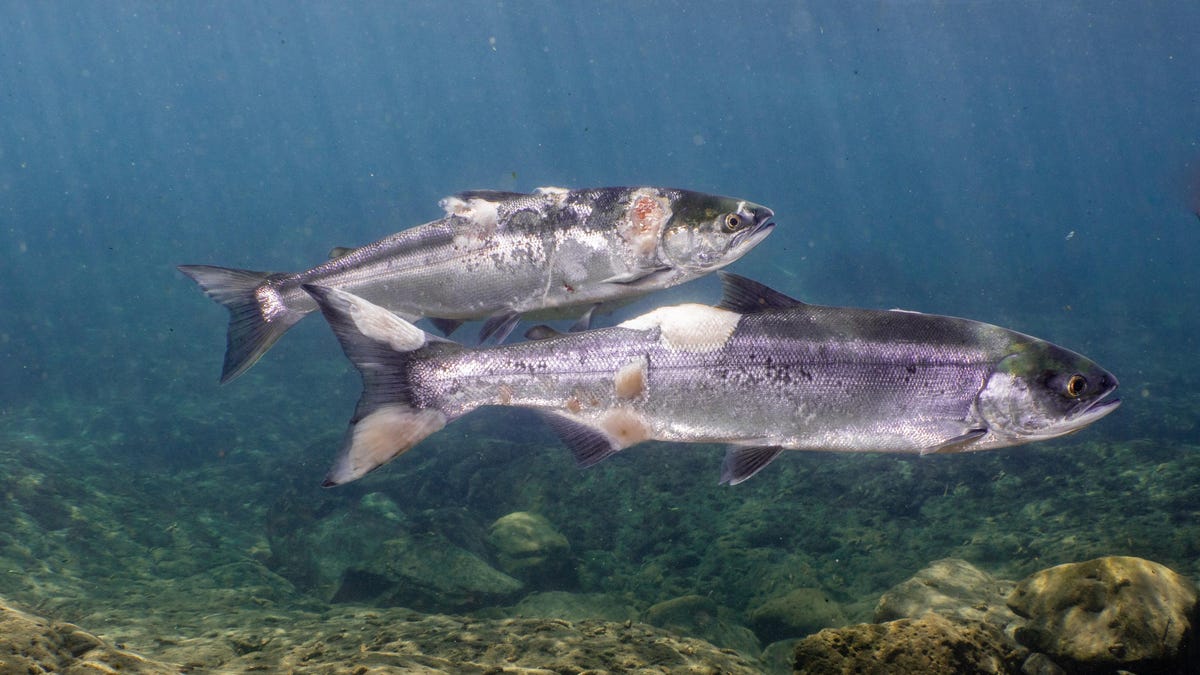
A shocking new video shows how, even though the record heat in the Pacific Northwest subsided earlier this month the effects are still rippling through ecosystems.AdvertisementColumbia Riverkeeper, an organization that monitors the Columbia River's most important salmon watersheds, released video and photos of sockeye salmon in a Columbia River tributary on Tuesday. The fish are covered in lesions, fungus and other signs that the unusually hot water conditions can lead to parasite growth.Heat-related stress and injuries will likely cause the death of salmon. Riverkeepers believe the salmon were trying to get back to the ocean after returning to their spawning grounds at Snake River, the largest tributary to the Columbia, when the heatwave hit. Salmon will head up smaller streams in an attempt to find cooler waters when this happens. However, the heat didn't allow for that to happen. The video was taken on the White Salmon River in Washington, which is a tributary to the Columbia River.Miles Johnson, a Columbia Riverkeeper senior attorney, stated that the Columbia and Lower Snake Rivers continue to rise in summer. These fish, and others like them, are still stranded.Current temperature in the Columbia River is 71°F (21.7°C). This is 3 degrees Fahrenheit (1.7° Celsius) higher than the safe levels for salmon and other cold-water-loving animals. The heat wave that swept the region was made more intense by climate change, but salmons are also suffering from other human activities. The Columbia and Snake Rivers dams have made water extremely hot for salmons. Because of the rapid moving and churning water, undammed rivers tend not to get as hot. However, dammed rivers are affected by stagnant water trapped within large reservoirs and stagnant waters that can heat faster. This summer saw low water levels, freakishly high temperatures and adverse impacts on the Columbia River Basin.Numerous salmon and steelhead runs are found in the watershed, with at least half of them endangered or threatened by too hot rivers. These fish are important for the livelihoods of the local Indigenous tribes. Last year, Washington State and Oregon claimed their Clean Water Act rights to ensure that waterways are free from temperature pollution. The federal government, which operates the dams on the Columbia River and Snake Rivers, must ensure that temperatures don't rise. Columbia Riverkeeper and other groups have also sued to address issues surrounding the river. This is what led to the Environmental Protection Agency setting a temperature threshold.Johnson stated that it is an ongoing problem. These hot cycles can push the entire system over the threshold.AdvertisementThis is not a problem that only affects one river basin. Similar circumstances are also occurring on the Sacramento River, California. Officials expect that nearly all juvenile salmon will die this summer because of extreme heat and low water flows tied to reservoir management. The state officials devised a bold plan to transport 17 million salmon hatchlings to sea from the Central Valley, rather than allowing them to travel the high-waterways. The issue is not limited to salmon. An estimated 1 billion sea animals were also cooked alive during the Pacific Northwest heat wave.Fish might not have as many habitats as they used to when river temperatures rise, Alison Colotelo, an Oregon Public Broadcasting fisheries biologist at Pacific Northwest National Laboratory said at the beginning of the heat wave. The risk is that they won't find cool, comfortable places to hang out.AdvertisementThese problems won't go away. Climate change will continue to increase temperatures and increase the likelihood of drought. Just this week, a study showed that extreme temperatures could increase by seven times in the next 30 years. Other research shows that the West is experiencing its worst drought in over 1,200 years. Other factors, such as large and destructive wildfires that can cause flooding to streams that normally cool them, could also be a factor in climate change. They could also pollute waterways, adding to an already complicated problem. Water managers will have to find a way to adapt the existing system. They also need to be able to start building a new system.Johnson stated that the government could reduce reservoir levels to make it less hot. However, this would limit other uses such as hydropower and grain barge access. Johnson suggested that the government could remove the dams to allow cold water to flow freely. This would be beneficial for the fish in the long-term.AdvertisementJohnson stated that if they don't get the Snake River back Johnson referred to salmon and they will go extinct. They won't be able to handle both climate change and the effects of dams together.
